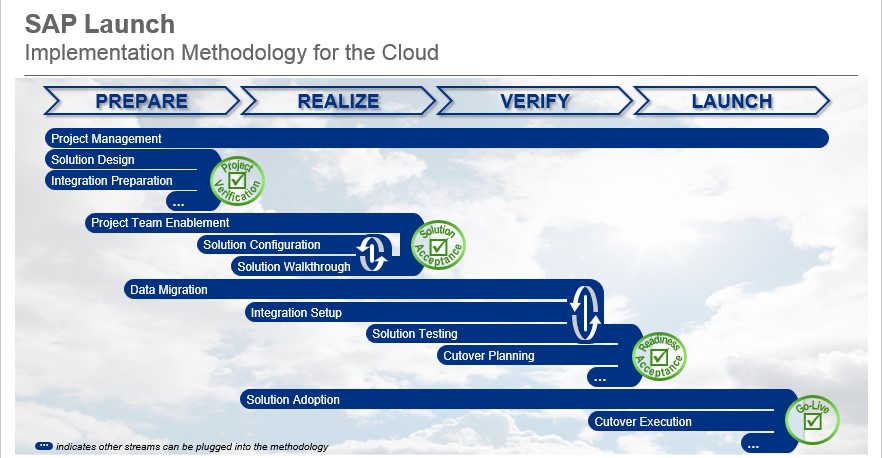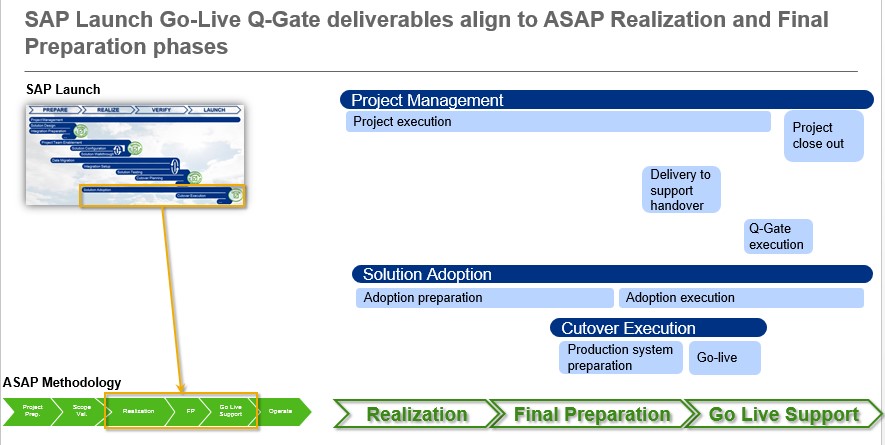
- SAP Community
- Products and Technology
- CRM and Customer Experience
- CRM and CX Blogs by Members
- SAP Hybrid Project implementation methodology – A ...
- Subscribe to RSS Feed
- Mark as New
- Mark as Read
- Bookmark
- Subscribe
- Printer Friendly Page
- Report Inappropriate Content
In any SAP implementations, methodology is a key factor for success of the entire implementation. For an on-premise solution of SAP, the well-known ASAP methodology is followed describing the phases and stages in the project.
For any SaaS Solution based project of SAP like Hybris Cloud for Customer, SAP has designed a new implementation methodology called as LAUNCH methodology.
In an implementation where-in both, the on-premise solution of SAP and an SaaS solution of SAP is involved, the methodology used is a conglomeration of LAUNCH and ASAP methodologies and such is called as HYBRID project.
While ASAP methodology is well-known, this document will aim at explaining the launch methodology and and hybrid project implementations and alignment of ASAP and Launch methodologies.
LAUNCH Methodology:
This is a new implementation strategy developed by SAP for all SaaS based solutions like Cloud for Customer. This consists of 4 phases and each phase would have a set of deliverables and quality gate also called as Q-Gate.

The four phases of this methodology are:
- Prepare phase
- Realize phase
- Verify phase
- Launch phase
At the completion of all activities in each phase of the methodology, there is a validation Quality gate / Q-Gate. On successful completion of activities related to that phase, the Q-Gate is marked completed. Below is the image showing the Q-gates for each phase and the validation point of successful clearing of the Q-gate.

Prepare phase: This is the first phase of the launch methodology which would be started at the beginning of the engagement / project. This phase is more involved with key business owners, project and program managers and architects of the project team to complete key activities like project plan preparation and design finalization. All stakeholders agree to the scope to be delivered during the implementation of the SAP solution. For any forth coming changes, a change request / change order is created and executed.
The key activities performed as part of this phase are:
- Project Management (though this activity is started in this phase, the activity would be continued till the end of the project and would be seen in all the other three phases).
- Solution Design
- Integration Preparation.
- Project team enablement
- Data migration templates
The Q-gate associated with this phase is called Project verification Q-Gate. During this activity, the stakeholders should agree upon the scope of the solution being delivered by the implementation team.
Realize phase: During this phase of the methodology the base line configuration is completed. The key activities performed as part of this phase are:
- Project Management (continuation from the prepare phase)
- Project team enablement
- Solution configuration
- Solution walk-through to the core business process owners.
- Integration setup
- Data migration to load 10% of data into the system
From the above mentioned activities, Solution walk-through activity is linked to “Solution acceptance quality gate. The key objective of this Q-Gate is to check if “all stakeholders agree that the business scenarios demonstrated in the solution meet the requirements to be delivered by the project and that all configuration questions have been addressed”.
Verify Phase: During this phase of the methodology, following activities are performed in the application:
- Project Management (continued from prepare phase)
- Integration setup completion
- Data migration
- Complete solution testing
- Cut-Over planning
“Readiness Acceptance” Quality gate is linked to solution acceptance activity in this phase. During this phase the solution is tested through all testing strategies like integration testing, performance testing and user acceptance testing. The main check for this Q-Gate would be address if “All stakeholders agree that the systems, data and people are ready to execute the cutover from the legacy system(s) to the new system(s).”
Launch Phase: This is the final stage of the methodology for the solution implementation. This is the phase to take the go / no-go decision and other key important activities:
- Project Management completion
- Solution adoption
- Cut-over execution
The Go-live quality gate is associated with the solution adoption and cut-over execution activities. The key objective of this Q-Gate is to check if “All stakeholders agree that the cutover is complete and the organization is prepared to use and support the new solution”.
For overall completion of the project, all the four above mentioned quality gates should be successfully marked completed by the business stake holders and the same is periodically audited by SAP.
Alignment between ASAP and launch methodologies:
In this section, first we shall cover what the key similarities are between ASAP and Launch. Below are the key similarities:
- Information Taxonomy: The ASAP and SAP Launch methodologies share the same information structure. Both methodologies use three levels for information presentation: phase, deliverable and task. In addition to the same hierarchy there are other similarities like the assignment of work stream to each deliverable and tasks; assignment of accelerators to tasks or deliverables and others.
- Quality Gates: Both ASAP and SAP Launch have key quality events in the delivery of the project that the project team uses to validate that key deliverables and activities have been completed. These events are called Quality Gates.
- Agile iterations and frequent review with users: Both methodologies leverage Agile principles like short iterations, validations with business users and cross-functional teams to accelerate implementation.
- The aligned information structure makes it very easy to combine the information from both methodologies into one harmonized WBS and schedule.
The below image shows the alignment between the different phases of ASAP and LAUNCH methodologies:

HYBRID Projects:
In the previous sections, launch methodology and its alignment with ASAP were covered in detail. In this section, we would introduce the HYBRID project as a conglomeration of LAUNCH and ASAP.
The term ‘hybrid project’ describes a project with concurrent implementation of a ‘core’ business solution like SAP ERP along with the implementation of a public cloud solution like SAP Hybris Cloud for Customer. In such projects SAP recommends to use the ASAP methodology for the entire project – e.g. use the ASAP lifecycle phases to structure the project. Project managers will need to bring the cloud specific deliverables (and associated tasks) from SAP Launch into the project WBS and project schedule.
The methodology milestone alignment picture shown earlier in this document provides a guideline on which deliverables go into which phase of ASAP. The following slides show the details for all SAP Launch deliverables.
The prepare phase of the LAUNCH is mapped to (Project Preparation + Scope Validation) phase of ASAP methodology as shown in the below image. Every activity covered under the prepare phase are holistically mapped to the activities performed under the two phases of ASAP methodology. The Project verification q-gate deliverables is aligned to deliverables from Project preparation and scope validation phases.

All deliverables of Realize phase of LAUNCH is mapped to partial set of deliverables from the realization phase of ASAP. The realization phase of ASAP has more deliverables than those from the realize phase of LAUNCH. Solution acceptance Q-Gate is aligned to deliverables from realization phase of ASAP.

The deliverables from combination of realize and verify phases would be logically mapped to deliverables from combination of realization and final preparation phases of ASAP. The complete list of deliverables in these phases are mapped in 1:1 ratio.

Finally the deliverables and go-live q-gate from the launch phase of LAUNCH is aligned to deliverables from the combination of realization and Final-preparation of ASAP.

- SAP Managed Tags:
- SAP Cloud for Customer add-ins
You must be a registered user to add a comment. If you've already registered, sign in. Otherwise, register and sign in.
-
ABAP
1 -
API Rules
1 -
c4c
1 -
CAP development
1 -
clean-core
1 -
CRM
1 -
Custom Key Metrics
1 -
Customer Data
1 -
Determination
1 -
Determinations
1 -
Introduction
1 -
KYMA
1 -
Kyma Functions
1 -
open SAP
1 -
RAP development
1 -
Sales and Service Cloud Version 2
1 -
Sales Cloud
1 -
Sales Cloud v2
1 -
SAP
1 -
SAP Community
1 -
SAP CPQ
1 -
SAP CRM Web UI
1 -
SAP Customer Data Cloud
1 -
SAP Customer Experience
1 -
SAP CX
1 -
SAP CX extensions
1 -
SAP Integration Suite
1 -
SAP Sales Cloud v2
1 -
SAP Service Cloud v2
1 -
SAP Service Cloud Version 2
1 -
Service Cloud v2
1 -
side-by-side extensions
1 -
Validation
1 -
Validations
1
- Innovate Faster: The Power Duo of SAP Activate and Scaled Agile Framework (SAFe) in CRM and CX Blogs by SAP
- Project Delivery Framework for SAP Marketing Cloud in CRM and CX Blogs by SAP
- Project Delivery Framework for SAP Commerce Cloud in CRM and CX Blogs by SAP
- SAP Premium Engagement Forum 'SAP EWM Roadmap and Transformation' (Virtual, March 29, 2023) in CRM and CX Blogs by SAP
- SAP Customer Data Platform Project Delivery Framework in CRM and CX Blogs by SAP